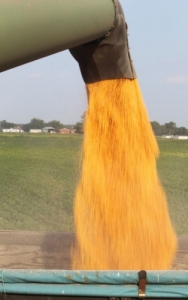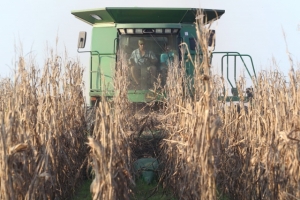Hot, dry weather leaves bad effect on corn
By Steve Herring
Published in News on August 31, 2018 5:50 AM

News-Argus/STEVE HERRING
A slow shutter speed on a camera makes the corn coming off the combine look like a waterfall.

News-Argus/STEVE HERRING
Eric Brown maneuvers a combine through a cornfield Monday afternoon in the New Hope community. Hot, dry conditions during the growing season took a toll on this year's crop.
William Earl Cruse props on the hood of a truck as the combine his son-in-law, Eric Brown, operates dumps a load of corn into the truck bed.
Cruse, 67, has farmed all of his life and is worried that he will not break even on his investment in 500 acres of corn.
He has about $450 in every acre and says he will have to pick 100 bushels per acre to really break even.
"We haven't got that far into it, but some of it is not too good," said Cruse, who owns Cruse Farms of LaGrange. "Some of it is about 30 bushels. It's ranged from 30 bushels to a 120 or 130. Last year we probably averaged around 120 or 130.
"The heat, it has been so hot and it did not get the rain needed. Really the heat did more to it than the dry weather did. It got so hot that it could not pollinate. When it gets over 90 degrees, it won't pollinate too good. It won't get no rain."
Other farmers across the county face a similar situation, he said. It just depends on when the crop was planted.
"This is the first field that I planted back in March, and I think that the earlier I planted the better it will be," Cruse said. "Them planted later, I don't think they will be as good.
"The rain just came too late. It will help the soybeans. But in some places they are drowned, too much water."
One extreme follows another, he said.
Cruse, who hopes to wrap up the corn harvest by October, started planting around March 15 and planted right on up to about the last of April.
"I really wasn't in a hurry," he said. "I was just trying to take my time so that I would have some planted all along."
Cruse thinks that even the later planted corn will be "pretty good." It just depends on where it was planted, he said.
"If you want corn, you have got to plant on corn land," Cruse said.
But there is not a lot of that in Wayne County, he said.
"Right down there in those bottoms where the dirt is black, corn will do a whole lot better," Cruse said. "But this lighter land, it just won't do as good unless you get the water."
The land didn't get that water until too late, Cruse said.
"Over here at Elroy, where we picked 30 bushels to the acre, it didn't hardly ever rain," he said. "There is more corn over there the same way, other people have the same problem that we have."
There is even some corn in the same shape right across the road from the field he was picking late Monday afternoon, he said.
Wayne County Extension Service crop agent Daryl Anderson agrees with Cruse that farmers need to average at least 100 bushels per acre to break even.
However, even then it depends on what price the crop receives; and at the moment, commodity prices for corn are going down, Anderson and Cruse have said.
"It dropped 7 cents today," Cruse said.
"Countywide corn is going to be kind of average," Anderson said. "If I had to say the best corn, it is going to be around Seven Springs, down in that area. I know around Fremont it don't look good.
"Actually in Fremont, the later corn is going to do a little better, but there is a lot of it that looks like 20 or 30 bushel corn. There is a lot in Fremont like that."
Dry weather also hurt the crop from Dudley to Grantham, Cruse said.
Anderson said he harvested a test plot in the Seven Springs area on Monday that picked 200 bushels per acre.
"But that goes back to what he said, you've got to have good corn land to make 200 bushels, and that is what that was," Anderson said. "But the five or six weeks of dry weather we had in June and July is what got us."
It is way too early to hazard a prediction on a countywide average, Anderson said.
"I have heard anywhere from 30 to 230," he said. "Guessing, I would say around 100, maybe because of what I have seen riding around. Overall, it is not the best crop this year.
"It is probably going to be soybeans or either cotton as long it will dry off for cotton."
The soybean crop is looking good; but like corn, it doesn't command a very good price at the moment, Anderson said.
"The only thing that has a good price is cotton," he said. "You are probably looking at two or three bales (per acre) the way it looks right now."
Cruse has about 1,200 acres in soybeans but no cotton.
"That's (soybeans) all we've got left to hang onto," Eric Brown said.
What farmers will be hanging onto are livestock and poultry, Anderson said.
"If it won't for that, we would be in trouble," he said.
Cruse also has a swine operation.
Brown, 41, has been farming for 21 years.
"It was as dry and hot as I have ever seen, and I don't know how the corn is doing as good as it is," Brown said. "The last I have seen it this bad, I think it was in 2010. It got hot and dry then, too.
"It's a mess, but you are coming off years that haven't been all that great, and you have so many farmers sitting on the fence. You have got to have a good one (year). If you have decent crop insurance, it ain't going to be enough to keep you farming."
Brown jokes that if farmers would take the amount of money they borrow every year and go to Las Vegas, they probably would come out ahead of what they earn farming.
"But somebody has got to do it (farm)," he said. "Somebody has got to do it."
